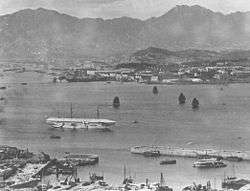HMS Tamar (1863)
 HMS Tamar at Malta, 1882 | |
| History | |
|---|---|
| Name: | HMS Tamar |
| Launched: | June 1863 |
| Fate: | Scuttled off old Wan Chai Ferry Pier (near today's Hong Kong Convention and Exhibition Centre), Hong Kong, 12 December 1941 |
| General characteristics | |
| Type: | Troopship |
| Displacement: | 4,650 tons |
| Tons burthen: | 2,812 tons |
| Length: | 320 ft (98 m) |
| Beam: | 45 ft (14 m) |
| Propulsion: | 1 propeller; 500 hp (373 kW) steam plant |
| Sail plan: | Barque rigged |
| Speed: | 12 knots (22 km/h; 14 mph) |
| Armament: | 3 guns |
HMS Tamar was a Royal Navy troopship built by the Samuda Brothers at Cubitt Town, London, and launched in Britain in 1863. She served as a supply ship from 1897 to 1941, and gave her name to the shore station HMS Tamar in Hong Kong (1897 to 1997).
History
The 1863 incarnation of HMS Tamar was the fourth to bear that name, which is derived from the River Tamar, in Cornwall, and the ship's crest is based on its coat of arms.[1] Built in Cubitt Town in East London, she was launched in June 1863, and began her maiden voyage on 12 January 1864 as a troopship to the Cape and China.[1]
Tamar was dual-powered with masts and a steam engine, giving a speed of 12 knots (22 km/h; 14 mph). She originally had two funnels, but she was re-equipped with a more advanced boiler and reduced to one funnel.[1]
In 1874, she formed part of the Naval Brigade that helped to defeat the Ashanti in West Africa, during the Ashanti War.[1] Tamar took part in the bombardment of Alexandria in 1882.
In 1879, The British Medical Journal reported a group of sailors aboard Tamar were poisoned by a bad pigeon pie which spawned an Admiralty investigation.[2]

In 1897 Tamar was hulked as a base ship and relieved HMS Victor Emmanuel as the Hong Kong receiving ship. She was used as a base ship until replaced by the shore station, which was named HMS Tamar, after the ship.
Tamar had been towed out to a buoy on 8 December during the Battle of Hong Kong during World War II. Amidst a curfew of darkness and bombardment by the Imperial Japanese forces, the orders came at 2100 hours on 11 December to scuttle her. She was scuttled at the buoy on 12 December 1941 once it was clear that the advance could not be arrested, to avoid being used by the invading Japanese forces. As the ship's superstructure became airlocked, the ship refused to sink for some time, until the Royal Artillery was called in to administer the coup de grâce.[1]
Over the years, legends state that a mast from the ship was erected outside Murray House in Stanley,[3] and that wood planks salvaged from the ship were turned into the main doors of St. John's Cathedral in the city's Central district.[4] The veracity of both legends, however, has been challenged.[5]
In late 2014, during dredging work for the Central–Wan Chai Bypass, the remains of what strongly appears to be Tamar were discovered at the location of the old Wan Chai Ferry Pier where she is believed to have been scuttled.[3] A government report, completed in September 2015 but released on the government's website in February 2017, finds strong evidence that the remains are those of Tamar.[6]
Notes
- 1 2 3 4 5 Eric Cavaliero, Harbour bed holds memories Archived 13 February 2009 at the Wayback Machine., The Standard, 13 November 1997
- ↑ "Poisoning By Pigeon-Pie". The British Medical Journal. 2 (968): 96–97. 19 July 1879. JSTOR 25251561.
- 1 2 Ryall, Julian (30 May 2015). "Wreck discovered in Hong Kong harbour could be scuttled HMS Tamar". The Daily Telegraph. Retrieved 29 January 2018.
- ↑ Wong, Ka Tong (2014). 藏在古蹟裡的香港 (The Hong Kong Hidden In Historical Artifacts) (in Traditional Chinese). Joint Publishing (H.K.) Co. Ltd. p. 74. ISBN 978-962-04-3532-4. Retrieved 26 January 2018.
- ↑ Davies, Stephen (12 August 2016). "All about the ship that gave Hong Kong's Tamar complex its name". South China Morning Post. Retrieved 29 January 2018.
- ↑ Cheng, Kris (2 March 2017). "Report finds strong evidence that Wan Chai wreckage is scuttled Hong Kong depot ship HMS Tamar". Hong Kong Free Press. Retrieved 29 January 2018.
References
- Colledge, J. J.; Warlow, Ben (2006) [1969]. Ships of the Royal Navy: The Complete Record of all Fighting Ships of the Royal Navy (Rev. ed.). London: Chatham Publishing. ISBN 978-1-86176-281-8. OCLC 67375475.
| Wikimedia Commons has media related to HMS Tamar (1863). |
| Preceded by HMS Victor Emmanuel |
Royal Navy receiving ship in Hong Kong 1873–1941 |
Succeeded by replaced by HMS Tamar (shore station) at Wellington Barracks, Hong Kong |